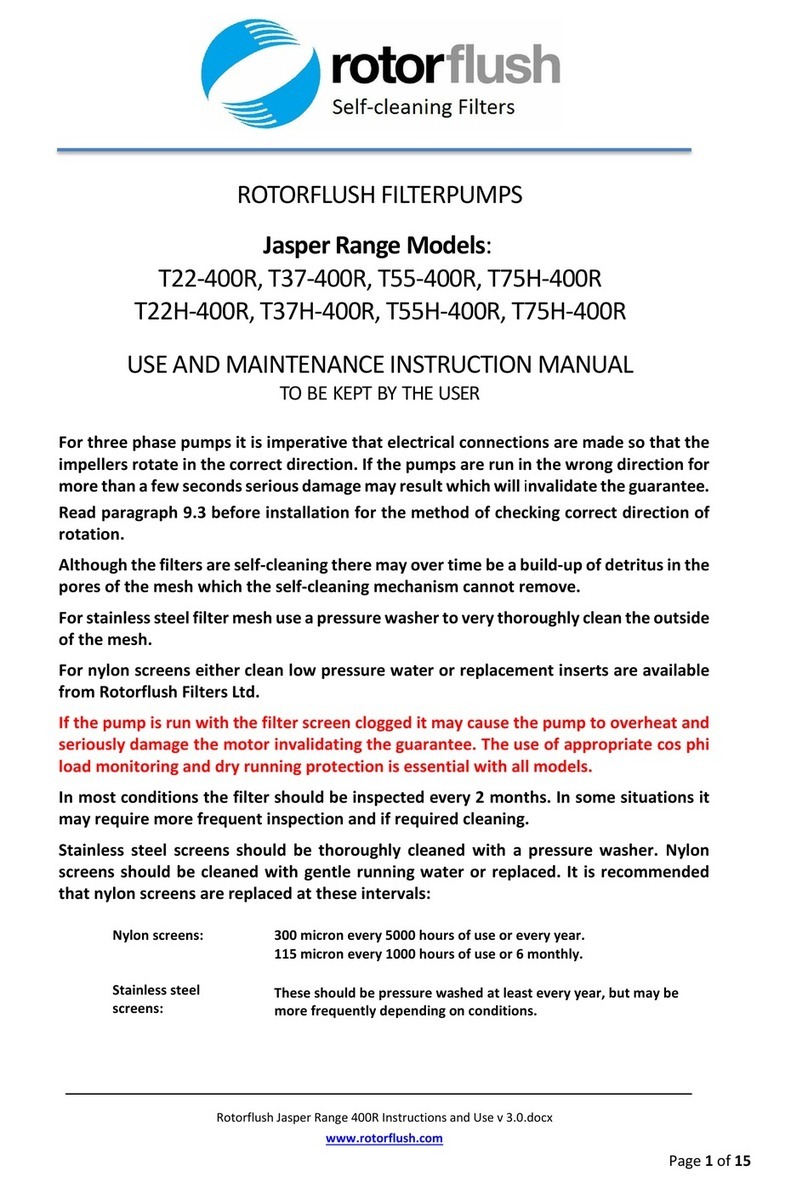
Cobalt Filterpump 400R Range Instruction Manual V.1.0 www.rotorflush.com
Page 2 of 14
Contents
1. MAN FACT RER & PROD CT IDENTIFICATION DATA (as per EEC98/37 p.1.7.4a).......................................3
1.1. Manufacturer Data ............................................................................................................................ 3
1.2. Filterpump Data.................................................................................................................................3
2. TECHNICAL ASSISTANCE INFORMATION .......................................................................................................3
3. INTROD CTION ............................................................................................................................................. 3
4. GENERAL SAFETY WARNINGS........................................................................................................................4
4.1. Preventive Measures to be taken by the ser ..................................................................................4
4.2. Significant Protection and Precautions (as per EEC 98/37 p. 1.1.2 and 1.7.2; EN 292-2 p.5). ........... 4
5. DESCRIPTION .................................................................................................................................................5
5.1. General Description ........................................................................................................................... 5
5.2. Technical and Construction Characteristics .......................................................................................5
6. TECHNICAL DATA CARD (as per EEC 98/37 p.1.1.2 and 1.7.2; EN 292-2 p................................................... 5
6.1. Pump Technical Data .........................................................................................................................5
6.2. Self-cleaning Filter Technical Data.....................................................................................................5
7. CONTEMPLATED AND NON-CONTEMPLATED SE ........................................................................................ 6
7.1. Contemplated Conditions of se.......................................................................................................6
7.2. Non-Contemplated Conditions of se ...............................................................................................6
8. HANDLING AND TRANSPORT (as per EEC 98/37 p. 1.7.4.a; EN 292-2 p.5 1.1.a) ...................................... 6
8.1. npacking ..........................................................................................................................................6
8.2. Handling and De-installing.................................................................................................................6
8.3. Transport ........................................................................................................................................... 7
9. PREPARATION FOR SE (as per EEC 98/37 p.1.7.4.a, EN 292-2 p.5.1.3)..................................................... 7
9.1. General information ..........................................................................................................................7
9.2. Electrical Connections........................................................................................................................7
9.3. Checking the Direction of Rotation....................................................................................................7
10. INSTALLATION (as per EEC 98/37 p. 1.7.4.a; EN 292-2 p.5.1.1b) ................................................................7
10.1. Fixed Installation...........................................................................................................................8
10.2. Temporary Installation (for Temporary se) ................................................................................9
11. ASSEMBLY AND DISASSEMBLY
12. ADJ STING AND REGISTERING
(as per EEC 98/37 p.1.7.4.a)....................................................................... 9
(as per EEC 98/37 p.1.7.4.a; EN 292-2 p.5.5.1.d)......................................9
13. SE AND START- P (as per EEC 98/37 p.1.7.4.a; EN 292-2 p. 5.5.1.d) .................................................... 10
13.1. Starting........................................................................................................................................10
14. MAINTENANCE AND REPAIRS (as per EEC 98/37 p.1.6; EN 292-2 p.5.5.1.e) ............................................ 10
14.1. Troubleshooting..........................................................................................................................11
15. TECHNICAL INFORMATION..........................................................................................................................12
15.1. Diagram of Filterpump Dimensions and Weights .......................................................................12
15.2. Diagram for Installation with Minimum Functional Distances....................................................12
15.3. Rating Plate Example ..................................................................................................................13
16. INFORMATION ON AIR-BORNE NOISE (as per EEC 89/392 p. 1.7.4.f)..........................................................14
17. WASTE DISPOSAL......................................................................................................................................... 14
18. DECLARATION OF CONFORMITY .................................................................................................................14





























